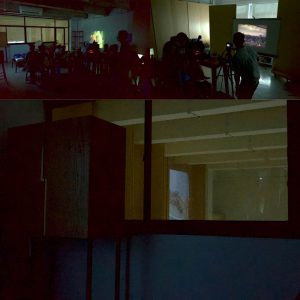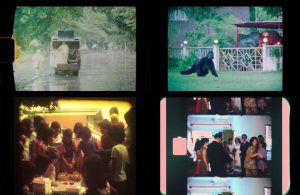While attending a conference in Istanbul, Dr. Alithea Binnie happens to encounter a djinn who offers her three wishes in exchange for his freedom. This presents two problems: first, she doubts that he’s real, and second, because she’s a scholar of story and mythology, she knows all the cautionary tales of wishes gone wrong. The djinn pleads his case by telling her fantastical stories of his past. Eventually, she’s beguiled and makes a wish that surprises them both.
| Reviewed by: Sasha Han
Four projectors operate simultaneously. Two showcase the home movies of Singapore’s locals and its expat community; the other pair serve as companion machines, one half projecting digitised supported films for the event, the other running its original Super 8 reel along its length every four hours or so. In this studio-turned-screening room, Super 8 home movies spanning the decades of 1960s and 1970s to more recent offerings are projected into a present-future. The set-up offers a compelling display of parallel and intersecting trajectories of home movie making in this country, of what is currently available, of what is not, of the largely oral tradition of passing decentralised local film history through generations. Matthew Yang remembers being mesmerised by 16mm film projections at the 2016 International Film Festival Rotterdam. He was there at the invitation of a friend whose film he worked on. Inside, there were two projectors in the middle of the cinema facing the screen. “I had never seen a format like that at a screening. That sat with me for a long time until I learned about Home Movie Day.” Now, Matthew, a audio-visual archivist pursuing his Masters, and his partner Wan Fong, a community organiser, move through dim swathes of the room — as yet unlit, for there is space enough for anything to be re-illuminated — serving as host and guide, warmly welcoming, chatting and guiding everyone who shows up through the space. Swirls of conversation and the rustle of foot traffic serve as lively accompaniment to the largely silent films.
The collection and display of home movies in Singapore is not new. The National Archives of Singapore (NAS) counts in its repositories a Peranakan wedding home movie dating to the 1930s. In 2019, Channel News Asia released Singapore on Film, a documentary tracking colonial depictions of the country for propaganda — the earliest, Coolie Boys Diving for Coins (1900), can be found in the British Film Institute — to expat Robert Waddle’s home movie “letters” to family back home, ending on a short segment of local renderings of private lives on film. This year, the Asian Film Archive screened the restored 16mm experimental films and home movies of independent filmmaking pioneer Rajendra Gour. But the cost of preservation and long-term storage is immense. To justify the expense, archivists often rely on the historical significance of the artefact (for example, who it belonged to) in making decisions on what to preserve and what not to. In his line of work, Matthew notes that “Bodies like NAS have collection policies. They have guidelines for what they collect and do not collect. I think where we come in is to look at things that are not typically presented.” The August launch of Home Movie Day Singapore is the first public event dedicated to bringing disparate and rare home movies by enthusiasts of the Super 8 format together. Weeks later, in conversation over assorted pastries and a breakfast fry-up, Wan Fong spoke about the informal setting and how delighted they were by the wide demographic of people who came. The intimate space encouraged conversation, and they were curious about how people heard about the event, where they came from and why they came. Matthew agrees. It was this openness to conversation and willingness to lean-in that brought these films together. “How do we map [home movie making] in Singapore? We know someone who shot a bit of this and that but we’re not really shooting in silos. Why not think of it as a community and consolidate the activity? There are a few of us who are here with the same passions, we can support one another.” Matthew and Wan Fong are acutely aware of the palimpsestic network of independent communities and larger institutions they tapped into to realise Home Movie Day Singapore. A palimpsest is a matrix of activity, made up of overlapping layers of interaction and intersection with what precedes its surface, ultimately taking on a multi-dimensional form. Home Movie Day Singapore is built on such a palimpsestic web, linked with other international Home Movie Days that branch out from a non-profit arm based in the USA, the Center for Home Movies. Kodak, also headquartered in the USA, sponsored Super 8 film stock that the supported films were shot on. Most heartening of all is the local filmmaking community’s support of the event. Momo Film Co offered their premises to host the event. The pair invited filmmaker friends and acquaintances to shoot a project of their choice on Super 8 film using a 1970s Leicina Special that was passed around as in a baton-relay before the cartridges were collated and shipped to nanolab Australia. Keen on “preserving the spirit that lingers through,” Wan Fong and Matthew credit filmmakers Gözde and Russel Zehnder, key figures in the experimental film on film scene in the early 2000s in their successful search for home movies from that time period and beyond (their films Take Me Home a.k.a I Saw Jesus and Infinity appear in the programme under their production banner Freestate).  1073732 In addition, a workshop that taught participants how to shoot, develop and screen a Super 8 film by the end of the two-day event was made possible by Felix Kottmann and Patrick Tung, both of whom were not only instrumental in the implementation of the workshop but also in organising the event with the couple. Local film processing facility Analog Film Lab took up the challenge of processing Super 8 overnight. “It took us a long time to figure it out but when it worked, they were like ‘Game on,’” Matthew enthuses. Lo Sheng, who co-founded the lab with Ernest How, says in an email that the photography community rallied around their mission to preserve analog film processing when professional labs began to close down. “Professionals from different domains in the [photography] community stepped forward to lend their expertise in electrical, mechanical, and chemical engineering to fine-tune processing parameters.” They had also reached out to Fujifilm for assistance in using their processing machines, and the company now provides them with the chemicals they need for processing. “It would have been impossible to continue our operation without their continuous support.” Viewed all at once, the differences and similarities of films from various communities and time periods could be more apparent. I ask if there was anything they found especially striking. “Someone came up to us and said that they enjoyed the different programming because they felt like the gaze that was used in the older films and newer films are very different,” Wan Fong recalls. Do you think the difference in the gaze had something to do with the tendency for home movies to be shot, developed and stored, viewed only when the impulse to “look back” arises? Matthew believes so. “The way [the older home movies were] made, they know that no one is going to really see it. It was more for record-keeping. But for the [commissioned] filmmakers, the questions they were asking were about what people wanted to see. So when they conceptualise they are already thinking of how to present it to an audience.” Beyond that, “Home movies are more or less quite universal. People who shoot home movies have almost the same intent really, to record precious events or milestones.” Just so. If anything, there has been an expansion of the concept of home. Where home movies of the 60s and 70s were largely confined to the family home, Wan Fong notes that in supported films such as Grace Song’s Ring Ring, Mama (2022) about a displaced ape that finds a family and a home in an HDB unit, “The idea of ‘home’ is [now] contextualised by the environment. [They] draw from beyond their homes, so the idea of ‘home’ is not just within the family or in a unit.” In Singapore, conversations around ownership tend to pivot on individual desires for housing. If we take the motivation of capturing subjects on film to illustrate its preciousness to the actors involved, then to capture public spaces on film is to afford the same attention and consideration for such spaces as one does for a place of one’s own. It is an implication of ownership, further, of a willingness to care for communal spaces and the liminal figures who pass through them.
It’s worth noting here that cameras, film and projectors are imported products, expensive to own and maintain; reels must be sent overseas for processing then shipped back. Wan Fong and Matthew point out the multi-storey bungalows and cars imprinted on older home movie negatives, asserting that “[The films are] a record of the middle to upper class. That’s recognising the limitation of what’s being recorded. Screen records are not representative.” Still, anything could turn up with their intentions to expand Home Movie Day Singapore beyond the limitations of working within a network, in which anything that is not in its purview remains excluded. “That comes with a presence,” Yang smiles. For now, the pair envision collaborations with NAS and regional communities. “Two guests from Thailand who run a Super 8 programme came…” Yang paused. “If Home Movie Day can even mimic or be like SEA Shorts and SEAFIC, it’s a direction we would like to go into.” May these expansive communities continue overlapping in this dazzling topography of home movie networks.
Home Movie Day Singapore 2022 consists of two film programmes. Selection 1 features films from Finbarr Fallon, Grace Song, Ivan Tan, Jonathan Choo, Juan Qi An, Mark Chua and Lam Li Shuen, Megan Lim En and Michael Kam. The films of Easy Lee, Felix Kottmann, Freestate and Barry Zehnder, Michael Rogge, Patrick Tung, Robert Wilson Collection, Salvatore Huang (Sloth Creatives) and Tang Kang Sheng appear in Selection 2. _ Sasha seeks to reify the fugitive effects of looking through language. She received her BA in 2021 and has worked with HBO Asia, the Singapore International Film Festival and the National Archives of Singapore. |
Click Here For More Film Reviews
Do you love writing? Send us a film review and we will feature it on our website. Any film that people can see in the theater or online. Email to: media@scape.sg
This review is also published on Sinema as part of *SCAPE’s Film Critics Lab: A Writing Mentorship Programme.




